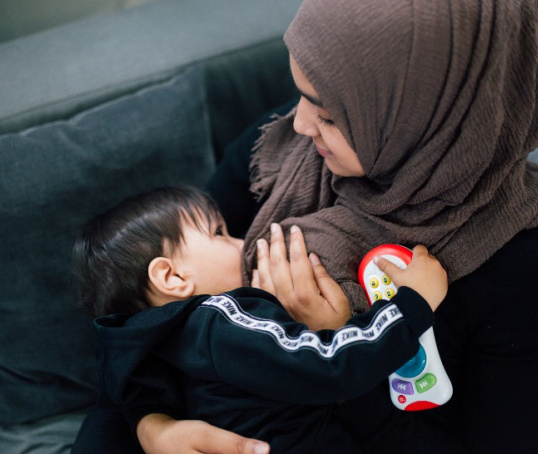If maternity (or paternity or shared) leave feels like a big unknown to you, read on for all of the crucial information.
Maternity leave: the basics
If you’re an employee, you’re entitled to take up to a year off work (Gov.uk, no date a; Maternity Action, 2022). How much time you take off though will probably be based on factors like your finances, career path and childcare.
Pay-wise, companies have different policies on how much you’ll get and for how long. But you’ll be entitled to at least Statutory Maternity Pay (SMP) (Gov.uk, no date a; Maternity Action, 2022).
The rules on ‘leave’ and ‘pay’ are different, so you need to check your entitlement to each separately (Gov.uk, no date a; Maternity Action, 2022).
How long is maternity leave?
If you’re an employee, you’re entitled to 52 weeks Statutory Maternity Leave. It doesn’t matter how long you’ve been with your employer, how many hours you work or how much you’re paid (Gov.uk, no date a; Maternity Action, 2022). Your leave is divided into two:
- Ordinary Maternity Leave: the first 26 weeks
- Additional Maternity Leave: the second 26 weeks (Gov.uk, no date a; Maternity Action, 2022)
You don’t have to take the whole 52 weeks but you must take two weeks after your baby is born (Gov.uk, no date a; Maternity Action, 2022).
How do I claim maternity pay and allowance?
At least 15 weeks before your due date, tell your employer that you’re pregnant and when your baby is due. You’ll also need to tell them when you want to start your maternity leave. They may ask you to do this in writing. They then have to write to you within 28 days confirming the start and end dates of your leave (Gov.uk, no date a; Maternity Action, 2022).
When can I take maternity leave?
Usually, the earliest you can start your maternity leave is 11 weeks before your baby is due (Gov.uk, no date a; Maternity Action, 2022). However, it can also start:
- The day after you have your baby if they’re early.
- If you’re off work for a pregnancy-related illness in the four weeks before your baby is due (Gov.uk, no date a; Maternity Action, 2022).
Remember though, you can work right up to the birth if you want to and feel up to it. Many women start their maternity leave later so they have more time with their baby when they’re born.
Shared Parental Leave
You have the option to split your leave with your partner, so that you both take a portion of your allocated allowance. That means that you could split the time between you, or take it at the same time. You’ll qualify for Statutory Shared Parental Pay (ShPP) that’s paid at the same rate as maternity or paternity (Gov.uk, no date b).
Adoption or surrogate pregnancies: maternity rights
If you’ve adopted a child or used a surrogate, you are still entitled to maternity, paternity or shared leave. You’ll also be entitled to time off for adoption appointments. For more information, visit the acas website or check out the government’s guide.
Maternity leave and allowance if you’re an agency worker, casual, zero hours worker or self-employed
If you’re self-employed, you’re not entitled to maternity leave that gives you the right to return to the same job after you’ve had your baby. But you can take a period off work and you may be eligible for Statutory Maternity Pay (SMP) or Maternity Allowance (MA), depending on how much you earn (Gov.uk, no date c; Maternity Action, 2022).
Holiday pay during pregnancy: what you accrue
If you are normally entitled to paid holiday, you continue to accrue it while on maternity leave. Almost all employees and workers are entitled to at least 28 days statutory paid holiday (this can include bank holidays) (Gov.uk, no date d; Maternity Action, 2022).
You might want to use some or all of your accrued holiday to extend your maternity leave. Or you could have a phased start back to work, e.g. working three days a week until your holiday is used up. If you want to go for this, agree it with your boss when you talk about your maternity leave.
It’s important to plan your holiday in advance so that you don’t lose any at the end of your annual leave year.
Keeping in touch days during maternity leave
On your maternity leave, you can do up to 10 keeping in touch (KIT) days without losing SMP or MA (Gov.uk, no date a; Maternity Action, 2022).
There are no specific rules about how much you get paid for KIT days, so you should ask your employer. Many employers pay what you would normally earn but they can offset it against your SMP so you should check first. They should pay at least the National Minimum Wage (Gov.uk, no date a; Maternity Action, 2022).
Not returning to work after maternity leave: what happens next
If your maternity leave ends and you decide that you don’t want to go back to your job, you’ll just resign in the normal way. However, you can give your notice during your maternity leave so you don’t actually have to spend those days in the workplace. If you give notice after your maternity leave’s up though – unless you take annual or sick leave – you will have to go into work (Gov.uk, no date a; Maternity Action, 2022).
This page was last reviewed in March 2022, amended November 2023.
Further information
Our support line offers practical and emotional support with feeding your baby and general enquiries for parents, members and volunteers: 0300 330 0700.
You might find attending one of our NCT New Baby courses helpful as they give you the opportunity to explore different approaches to important parenting issues with a qualified group leader and other new parents in your area.
Make friends with other parents-to-be and new parents in your local area for support and friendship by seeing what NCT activities are happening nearby.
ACAS Helpline Online can answer questions on employee rights.
The Equality Advisory Support Service on 0808 800 0082 (freephone).
Gov.uk for information on pregnancy and maternity rights and flexible working in the workplace
Health and Safety Executive for information for new and expectant mothers
Maternity Action for online information and advice on maternity and parental rights at work on 0808 802 0029.
Working Families helpline on 0300 012 0312. See the Working Families' maternity calendar for at-a-glance information about your rights.
Gov.UK. (no date a) Maternity pay and leave. Available at: https://www.gov.uk/maternity-pay-leave/leave [Accessed 28th March 2022]
Gov.UK. (no date b) Shared Parental Leave and Pay. Available at: https://www.gov.uk/shared-parental-leave-and-pay [Accessed 28th March 2022]
Gov.UK. (no date-c) Maternity Allowance. Available at: https://www.gov.uk/maternity-allowance [Accessed 28th March 2022]
Gov.UK. (no date-d) Holiday entitlement. Available at: https://www.gov.uk/holiday-entitlement-rights [Accessed 28th March 2022]
Maternity Action. (2022) Pregnant at work. Available at: https://www.maternityaction.org.uk/advice-2/mums-dads-scenarios/pregnant/pregnant-at-work/] [Accessed 31st March 2022]





